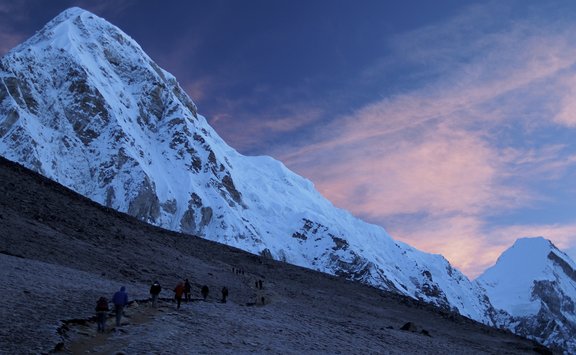Science and Spirit: Jake Gyllenhaal Meets Jon Krakauer’s Everest Story
By Cara Cannella

View of Mount Everest from Kala Patthar, Nepal. Photo by Grant Eaton via Flickr.
Since it was announced earlier this month that the release of Universal Pictures’ 3-D “Everest” has been pushed back to September 2015, the disappointed legions include Jake Gyllenhaal fans eager to see the bare-bodied star take on its leading role, as well as devoted readers of Jon Krakauer, author of Into Thin Air, a nonfiction account of the tragic 1996 trek upon which the film is based.
Since we fall into both camps, we were happy to stumble upon this GQ interview, in which Gyllenhaal articulates an appreciation for the craft of climbing Everest that might as well be a commentary on Krakauer’s approach to writing:
"What I loved about the process of researching Everest is just what a science it all is," he says. "You can believe in the sense of adventure, and you can create nostalgia based on some lofty idea of it, but ultimately to conquer that mountain requires great discipline -- using your critical, analytical mind -- as well as that spirit we all talk about."
Krakauer is among nineteen interviewees in The New New Journalism, along with Gay Talese, a pioneer of the form, and Susan Orlean, whose own work has been adapted for film. In his editor's preface to the book, Robert S. Boynton reveals his motivation for collecting conversations with America’s best nonfiction writers on their craft: "What is crucial is that every writer have a method…ways to organize one's writing life. This book is my answer to that question."
In shedding light on the creative and analytic process behind his many books, including Into Thin Air, an account of eight climbers' fatal attempts to ascend the world’s highest mountain, Into The Wild, and Under the Banner of Heaven, Krakauer reveals that rock climbing, of all things, taught him to structure and outline his work:
"When you embark on a really big climb like, say, the Salathé wall of El Capitan, which rises three thousand vertical feet from the floor of Yosemite Valley, the enormity of the undertaking can be paralyzing. So a climber breaks down the ascent into rope-lengths, or pitches. If you can think of the climb as a series of thirty or forty pitches, and focus on each of the pitches to the exclusion of all the scary pitches that still lie above, climbing El Cap suddenly isn’t such an intimidating prospect. By following an outline, I can focus on the chapter that’s in front of me, without having to worry about all the inevitable problems to come. It makes writing a book much less terrifying."
In a detailed breakdown of his methodology, he explains his winnowing down of a general outline, consisting of forty or fifty of a story’s most interesting scenes or incidents, to "three to five pages of a yellow legal pad" containing "a two- or three-line précis of each scene." At all times, even while climbing, he carries several small reporter’s notepads, and at the end of a workday, he writes in six-by-nine inch spiral notebooks, using "a blue fine-point Pilot Precise Rolling Ball pen for taking notes and a red one for underlining important passages."
Given Krakauer's wide range of life experiences and the emphasis on structure in his writing, it's no surprise to learn that before launching a successful freelance writing career, he worked as a carpenter. Although he doesn't spell out how the hands-on experience of working from a blueprint taught him how to lay the foundation and build a frame for a story, lessons of the trade must have been influential, along with those from rock climbing and writers who showed him the way (Joan Didion, Tracy Kidder, and Philip Caputo are among his list of more than two dozen):
“Whenever I would come across a passage by one of these writers that blew my socks off, I would read the sentences over and over until I understood what gave the writing such power. That’s how I learned technique. I paid close attention to what these authors quoted and whom, where they went, what they observed. I studied how they began their books and/or articles, and how they ended them. Reading these writers is what I did instead of attending journalism school.”
Krakauer's revelation of the inspiration behind his process -- from what it takes to scale a mountain to peaks of accomplishment by his literary heroes -- embodies the synthesis of spirit and science that compels Gyllenhaal, and so many of us, to support imagination with on-the-ground work. To what do you ascend, and how do you get there?
